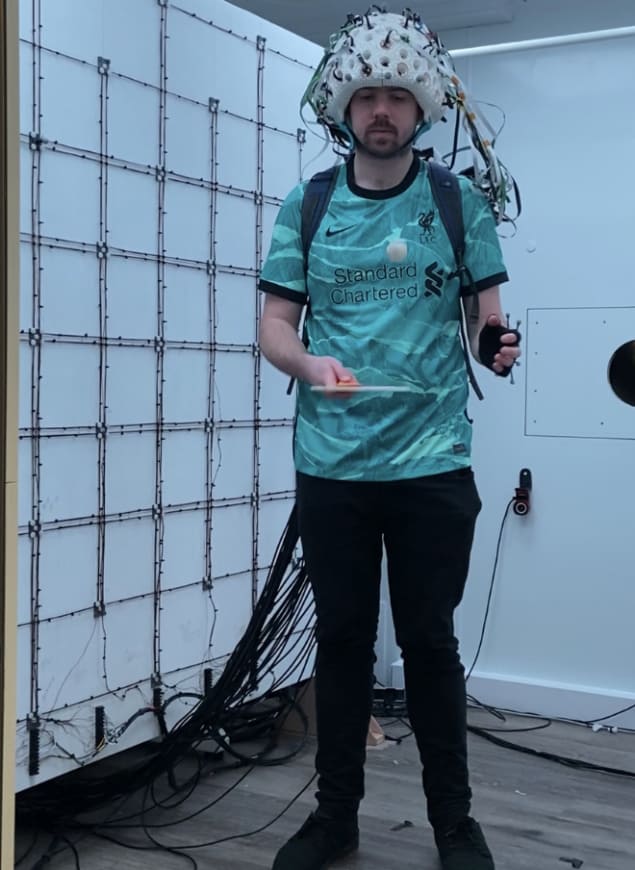
A UK-based research team has created a wearable brain scanner that can measure brain function while people are standing and walking around, paving the way for better understanding and diagnosis of neurological problems that affect movement.
As part of the project, a University of Nottingham-led team combined compact sensors with precision magnetic field control to measure tiny magnetic fields generated by the brain, enabling highly accurate recordings to be made during natural movement. The results, presented in NeuroImage, describe how the team mounted around 60 sugar-cube-sized magnetic field sensors, known as optically pumped magnetometers (OPMs), into lightweight wearable helmets to enable freedom of movement during a magnetoencephalography (MEG) recording.
As Niall Holmes, research fellow at the University of Nottingham, who led the research, explains, the project focuses on imaging the function of the human brain in “completely natural settings” to deepen understanding of what happens in our brains when we learn to walk – or of what goes wrong in the brains of patients with conditions where movement becomes impaired or uncontrollable.
“Conventional neuroimaging systems, such as MRI scanners, are simply too restrictive for us to perform natural movements, and EEG recordings during movements produce artefact-ridden data,” Holmes says.
Needle in a haystack
Neurons in the brain communicate via electric potentials and neuronal currents that produce an associated magnetic field. Measuring these fields outside the head with MEG recordings allows researchers to determine the underlying neuronal activity with uniquely high spatiotemporal precision. However, according to Holmes, this process presents a significant challenge.
“The neuronal magnetic fields are on the femtotesla level, over one billion times smaller than the magnetic field of the Earth, and many orders of magnitude smaller than magnetic fields generated by sources such as mains electricity and moving vehicles; it’s like looking for a needle in a haystack,” he says.
To address this limitation, the team built on recent developments in the miniaturization of quantum technologies to create highly accurate OPMs that work by measuring the transmission of laser light through a glass cell filled with a vapour of rubidium atoms. The laser optically pumps the atoms, which aligns the electron spins. At zero magnetic field, all spins are aligned, and no more laser light can be absorbed, so a measurement of the intensity of the laser light exiting the glass cell is at a maximum.
“When a small magnetic field is applied near the cell, the spins fall out of alignment, and need to absorb more photons of laser light to re-align with the pumping laser. As photons are absorbed, the measured intensity decreases,” explains Holmes. “By monitoring the intensity of the laser light that is transmitted through the cell, we can infer the local magnetic field experienced by the atoms.”
Matrix coil
The Nottingham team also developed a “matrix coil” – a new type of active magnetic shielding made from small, simple, unit coils, each with individually controllable current – that can be redesigned in real time to shield any region in a magnetically shielded room (MSR). This allows the OPMs to continue to function as patients move freely.
“Using our matrix coil we have demonstrated, for the first time, that accurate MEG data can be acquired during ambulatory movements. This sets the groundwork for many clinical and neuroscientific paradigms that would be impossible using conventional neuroimaging systems,” says Holmes.
“For example, the scanning of patients with disorders that affect movement and balance, such as Parkinson’s disease, concussions and gait ataxia, will directly activate the brain networks associated with the movements they find most challenging, increasing our sensitivity to the neural correlates of the disorders,” he adds.

Cerca Magnetics bags qBIG Prize for quantum innovation
According to Holmes, freedom of movement also enables studies of spatial navigation and natural social interaction, as well as longitudinal neurodevelopment studies and the recording of epileptic activity during seizures. In doing so, it creates what he describes as “an entirely different set of boundaries for researchers and clinicians”.
“It’s exciting to think of what we might be able to learn in these areas. We are now in the process of commercializing the technology with our spin-out company Cerca Magnetics to enable these new studies,” he says.



